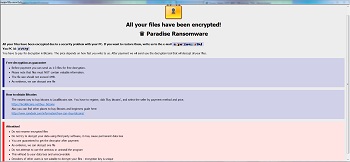Ransom.Win32.PARADISE.A
Trojan-Ransom.Win32.Instructions.bj(Kaspersky); TR/AD.ParadiseRansom.B(ANTIVIR)
Windows


Threat Type: Ransomware
Destructiveness: No
Encrypted:
In the wild: Yes
OVERVIEW
This Ransomware arrives on a system as a file dropped by other malware or as a file downloaded unknowingly by users when visiting malicious sites.
However, as of this writing, the said sites are inaccessible.
It drops files as ransom note.
TECHNICAL DETAILS
Arrival Details
This Ransomware arrives on a system as a file dropped by other malware or as a file downloaded unknowingly by users when visiting malicious sites.
Installation
This Ransomware adds the following processes:
- %Windows%\sysnative\vssadmin.exe delete shadows /all /quiet
- cmd.exe "ping 127.0.0.1 && del {Malware Name}.exe
- C:\Windows\System32\mshta.exe %User Startup%\{random characters}.hta

Process Termination
This Ransomware terminates processes or services that contain any of the following strings if found running in the affected system's memory:
- mysql
- IBM
- bes10
- black
- sql
- store.exe
- vee
- postg
- sage
- ShadowProtectSvc
- SPAdminV4
- SPTimerV4
- SPTraceV4
- SPUserCodeV4
- SPWriterV4
- SPSearch4
- firebirdguardiandefaultinstance
- Simply Accounting Database Connection Manager
- ibmiasrw
- QBPOSDBServiceV12
- QBCFMonitorService
- QBVSS
- mr2kserv
- WinDefend
- MSExchangeADTopology
- SQLWriter
- ReportServer$ISARS
- SQLBrowser
- IISADMIN
- IBM Domino Server (CProgramFilesIBMDominodata)
- MSExchangeSA
- MSExchangeIS
- IBM Domino Diagnostics (CProgramFilesIBMDomino)
- QuickBooksDB25
- QuickBooksDB24
- QuickBooksDB23
- QuickBooksDB22
- QuickBooksDB21
- QuickBooksDB20
- QuickBooksDB19
- QuickBooksDB18
- QuickBooksDB17
- QuickBooksDB16
- QuickBooksDB15
- QuickBooksDB14
- QuickBooksDB13
- QuickBooksDB12
- QuickBooksDB11
- QuickBooksDB10
- QuickBooksDB9
- QuickBooksDB8
- QuickBooksDB7
- QuickBooksDB6
- QuickBooksDB5
- QuickBooksDB4
- QuickBooksDB3
- QuickBooksDB2
- QuickBooksDB1
- MSExchangeFBA
- SQLAgent$MSFW
- SQLAgent$ISARS
- MSSQL$MSFW
- MSSQL$ISARS
- MSSQLServerADHelper100
Dropping Routine
This Ransomware drops the following files:
- %Application Data%\parid.bin - contains unique code
- %User Startup%\{random characters}.hta
- %User Startup%\{random characters}.exe
(Note: %Application Data% is the current user's Application Data folder, which is usually C:\Documents and Settings\{user name}\Application Data on Windows 2000, XP, and Server 2003, or C:\Users\{user name}\AppData\Roaming on Windows Vista, 7, and 8.. %User Startup% is the current user's Startup folder, which is usually C:\Windows\Profiles\{user name}\Start Menu\Programs\Startup on Windows 98 and ME, C:\WINNT\Profiles\{user name}\Start Menu\Programs\Startup on Windows NT, C:\Documents and Settings\{User name}\Start Menu\Programs\Startup on Windows XP, or C:\Users\{user name}\AppData\Roaming\Microsoft\Windows\Start Menu\Programs\Startup on Windows Vista, 7, and 8.)
Other Details
This Ransomware connects to the following possibly malicious URL:
- {BLOCKED}er.org/{random characters}
It does the following:
- Checks the language of the target computer
- if Russian, Kazakhstan, belarusian, Ukrainian, and tatar, execute "cmd.exe "ping 127.0.0.1 && del ""{Malware Name}.exe"""
- if it failed, do non compatible language behavior
- if successful, terminate itself
- else continue encryption
However, as of this writing, the said sites are inaccessible.
Ransomware Routine
This Ransomware avoids encrypting files found in the following folders:
- Windows
- $Recycle Bin
- System Volume Information
- Program Files
- Program Files(x86)
It renames encrypted files using the following names:
- {encrypted file}{unique code}{{BLOCKED}t@p-security.li}.exploit
It drops the following file(s) as ransom note:
- {all folders encrypted}\Instructions with your files.txt

SOLUTION
Step 1
Before doing any scans, Windows 7, Windows 8, Windows 8.1, and Windows 10 users must disable System Restore to allow full scanning of their computers.
Step 2
Identify and terminate files detected as Ransom.Win32.PARADISE.A
- Windows Task Manager may not display all running processes. In this case, please use a third-party process viewer, preferably Process Explorer, to terminate the malware/grayware/spyware file. You may download the said tool here.
- If the detected file is displayed in either Windows Task Manager or Process Explorer but you cannot delete it, restart your computer in safe mode. To do this, refer to this link for the complete steps.
- If the detected file is not displayed in either Windows Task Manager or Process Explorer, continue doing the next steps.
Step 3
Search and delete these components
- %Application Data%\parid.bin
- %All Users Profile%\Microsoft
- %User Startup%\{random characters}.hta
- %User Startup%\{random characters}.exe
Step 4
Scan your computer with your Trend Micro product to delete files detected as Ransom.Win32.PARADISE.A. If the detected files have already been cleaned, deleted, or quarantined by your Trend Micro product, no further step is required. You may opt to simply delete the quarantined files. Please check the following Trend Micro Support pages for more information:
Step 5
Restore encrypted files from backup.
Did this description help? Tell us how we did.

